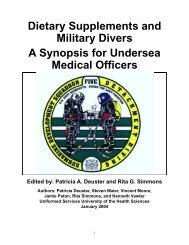Force Health Protection: Nutrition and Exercise Resource Manual
Force Health Protection: Nutrition and Exercise Resource Manual
Force Health Protection: Nutrition and Exercise Resource Manual
Create successful ePaper yourself
Turn your PDF publications into a flip-book with our unique Google optimized e-Paper software.
Reference st<strong>and</strong>ards have been developed to identify individuals at risk<br />
for being either over- or underweight. However, BMI can misclassify some<br />
large frame or muscular people as overweight. It is strictly a ratio <strong>and</strong> does<br />
not necessarily reflect percent body fat accurately. If you feel your BMI<br />
incorrectly categorizes you, have your percent body fat measured by a trained<br />
professional. Body fat can be determined from a variety of techniques<br />
including hydrostatic (underwater) weighing, or from skinfolds <strong>and</strong><br />
circumference (as done in the Navy) measures.<br />
Fat Distribution<br />
In addition to BMI, it is helpful to know your waist-to-hip ratio (WHR).<br />
This ratio determines your pattern of fat distribution, i.e., where you store<br />
body fat. The formula for calculating waist-to-hip ratio is:<br />
Worksheet 1-4. Calculate Your Waist-to-Hip Ratio<br />
Your WHR = ÷ =<br />
waist circumference (inches) hip circumference (inches)<br />
Table 1-3. St<strong>and</strong>ards for Waist-to-Hip Ratios<br />
Men<br />
Women<br />
< 0.95 < 0.80<br />
Measuring<br />
waist <strong>and</strong> hip<br />
circumferences<br />
using a tape<br />
measure.<br />
Adapted from OPNAVINST 6110.1E, March 1998 p.7-8.<br />
The appropriate ratios for men<br />
<strong>and</strong> women are listed in Table 1-<br />
3. Ratios greater than these<br />
indicate a tendency toward<br />
central (torso) obesity. People<br />
who store excess fat centrally, as<br />
opposed to in their extremities,<br />
are at increased risk for<br />
cardiovascular (heart <strong>and</strong> blood<br />
vessel) diseases <strong>and</strong> diabetes.<br />
This chapter serves as an anchor around which the remaining chapters<br />
have been developed. In the following chapters you will learn sound<br />
nutritional practices <strong>and</strong> ways to enhance your physical performance.<br />
Importantly, you will see how good nutrition <strong>and</strong> a balanced exercise<br />
program together influence your physical fitness, military readiness, <strong>and</strong><br />
ultimately your overall health.<br />
6 <strong>Force</strong> <strong>Health</strong> <strong>Protection</strong>:




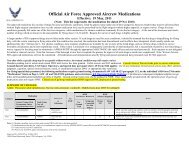
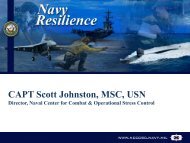
![Body Composition and Military [PDF] - Human Performance ...](https://img.yumpu.com/43269347/1/190x245/body-composition-and-military-pdf-human-performance-.jpg?quality=85)
![Tips for Grocery Shopping [PDF]](https://img.yumpu.com/37447379/1/190x245/tips-for-grocery-shopping-pdf.jpg?quality=85)
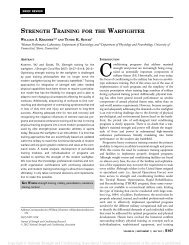
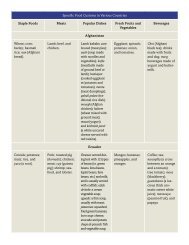
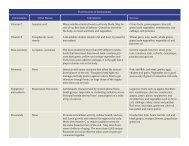
![Synthetic Drugs [PDF] - Human Performance Resource Center](https://img.yumpu.com/37447322/1/190x245/synthetic-drugs-pdf-human-performance-resource-center.jpg?quality=85)
